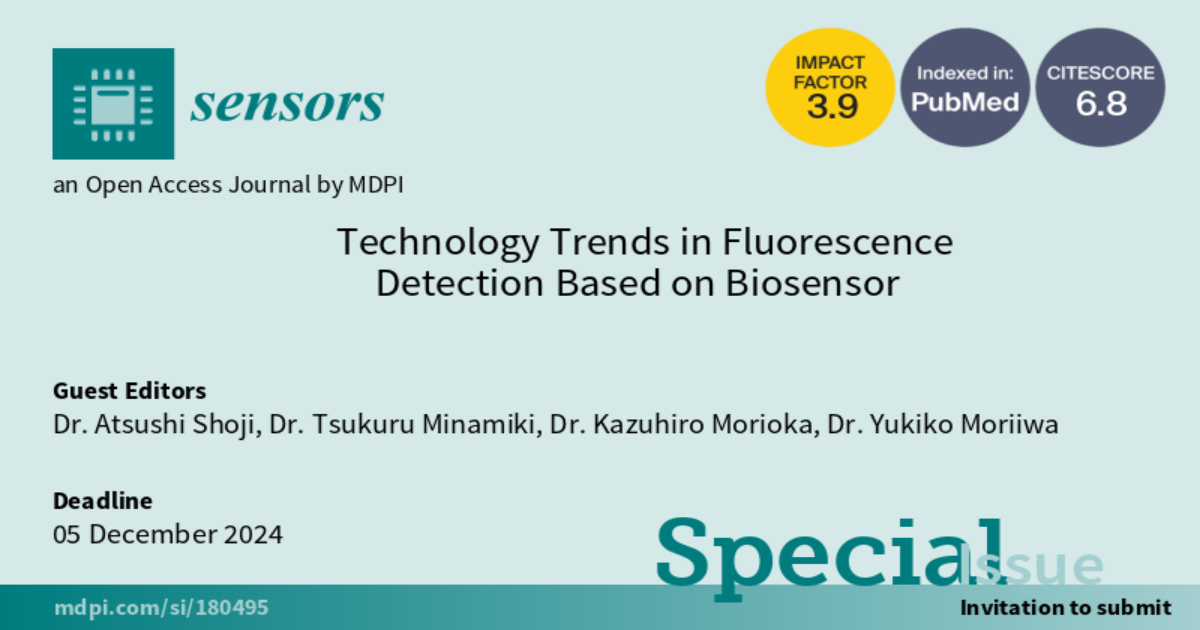Technology Trends in Fluorescence Detection Based on Biosensor
A special issue of Sensors (ISSN 1424-8220). This special issue belongs to the section "Biosensors".
Deadline for manuscript submissions: 5 December 2024 | Viewed by 3063

Special Issue Editors
Interests: lipid membrane; bio-analysis; biosensor
Special Issues, Collections and Topics in MDPI journals
Interests: molecular sensors; molecular assemblies; molecular devices
Interests: microfluidics; lab-on-a-chip; sensor material
Special Issue Information
Dear Colleagues,
Fluorescence-based sensors have been a growing research field for many years. Among fluorescent sensors, biosensors have progressed remarkably, and many researchers have developed superior sensors that can measure not only biological macromolecules such as proteins and nucleic acids, but also small molecules such as amino acids, sugars, and pharmaceuticals. Therefore, these are becoming an indispensable measurement technology in the fields of pharmaceuticals, agriculture, and the environment. If fluorescent probes are also considered a category of sensors, fluorescent imaging techniques using these probes are very useful for solving unknown biological processes in tissues or cells. On the other hand, sensors for on-site analysis must be usable by anyone, anywhere, at any time, and therefore measurement operation must be not only very simple but also quick. Increasing the sensitivity of these sensors is an important mission, and an approach to solving this problem has been reported using the phenomenon of fluorescence intensity enhancement through the use of inorganic metal nanomaterials. In this Special Issue, we welcome submissions of papers that introduce new principles of sensors and applications of sensors to discuss new possibilities of fluorescence-based sensors, which are making remarkable progress as described above.
Dr. Atsushi Shoji
Dr. Tsukuru Minamiki
Dr. Kazuhiro Morioka
Dr. Yukiko Moriiwa
Guest Editors
Manuscript Submission Information
Manuscripts should be submitted online at www.mdpi.com by registering and logging in to this website. Once you are registered, click here to go to the submission form. Manuscripts can be submitted until the deadline. All submissions that pass pre-check are peer-reviewed. Accepted papers will be published continuously in the journal (as soon as accepted) and will be listed together on the special issue website. Research articles, review articles as well as short communications are invited. For planned papers, a title and short abstract (about 100 words) can be sent to the Editorial Office for announcement on this website.
Submitted manuscripts should not have been published previously, nor be under consideration for publication elsewhere (except conference proceedings papers). All manuscripts are thoroughly refereed through a single-blind peer-review process. A guide for authors and other relevant information for submission of manuscripts is available on the Instructions for Authors page. Sensors is an international peer-reviewed open access semimonthly journal published by MDPI.
Please visit the Instructions for Authors page before submitting a manuscript. The Article Processing Charge (APC) for publication in this open access journal is 2600 CHF (Swiss Francs). Submitted papers should be well formatted and use good English. Authors may use MDPI's English editing service prior to publication or during author revisions.
Keywords
- on-site analysis
- cell analysis
- imaging
- fluorescent protein
- fluorescent quantum dot
- fluorescent polymer
- fluorescence particle
- microlfluidics
- lab-on-a-chip
Benefits of Publishing in a Special Issue
- Ease of navigation: Grouping papers by topic helps scholars navigate broad scope journals more efficiently.
- Greater discoverability: Special Issues support the reach and impact of scientific research. Articles in Special Issues are more discoverable and cited more frequently.
- Expansion of research network: Special Issues facilitate connections among authors, fostering scientific collaborations.
- External promotion: Articles in Special Issues are often promoted through the journal's social media, increasing their visibility.
- e-Book format: Special Issues with more than 10 articles can be published as dedicated e-books, ensuring wide and rapid dissemination.
Further information on MDPI's Special Issue polices can be found here.









